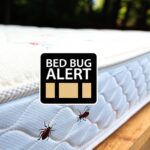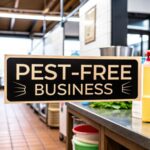Integrated Pest Management (IPM) is really just a common-sense way of dealing with pests. It’s all about playing the long game – preventing problems before they start, instead of just reacting with chemicals every time something pops up. Think of it as a smarter, more sustainable approach that’s better for your wallet and the environment.
Thinking Like a Detective, Not an Exterminator
Forget the textbook definitions for a second. The easiest way to get your head around IPM is to imagine your farm, garden, or even your home as a patient. A good doctor doesn’t just prescribe the strongest possible medicine for a simple cough; they figure out what’s actually causing it first. IPM brings that same diagnostic mindset to pest control.
Instead of grabbing a spray bottle at the first sign of trouble, an IPM professional puts on their detective hat. They start by asking the right questions:
- What exactly is this pest? You can't solve a problem if you don't know what it is. Proper identification is everything.
- How many are there? A couple of aphids on a rose bush isn't a crisis. A full-blown infestation is a different story.
- Why are they thriving here? Is there a leaky pipe providing moisture? A specific plant they love? Or a gap in the wall letting them in?
- Can I stop them without chemicals? Sometimes the best solution is improving the soil, bringing in a natural predator, or just sealing an entry point.
This completely changes the goal. You’re no longer just trying to kill pests; you’re trying to create an environment where they can’t get a foothold in the first place.
A Smarter, Not Harder, Approach
This doesn’t mean throwing out pesticides altogether. Far from it. IPM simply treats them as one tool in a much bigger toolbox—something to be used carefully and only when really necessary. It’s a flexible approach that mixes timeless farming wisdom with modern science.
An IPM strategy is a holistic approach that prioritises the health of the entire ecosystem. By focusing on prevention and monitoring, it reduces reliance on chemical interventions, safeguarding beneficial insects, soil quality, and local biodiversity for the long term.
This way of thinking is really catching on here in the UK. Since 'IPM Assessment Plans' were introduced in late 2020, over 17,000 UK farmers have started to properly review how they manage pests. While everyone is at a different stage, it shows a clear shift towards working smarter and more sustainably. You can read more about IPM adoption across the UK on the Journal of the Science of Food and Agriculture website.
IPM vs. Conventional Pest Control at a Glance
To really see the difference, it helps to compare the old way of thinking with the modern IPM approach. The table below breaks down the fundamental shift in mindset.
| Aspect | Conventional Pest Control | Integrated Pest Management (IPM) |
|---|---|---|
| Primary Goal | Eradicate pests immediately. | Manage pests to acceptable levels and prevent future issues. |
| Approach | Reactive – spray when pests appear. | Proactive – focus on prevention, monitoring, and early intervention. |
| Main Tool | Chemical pesticides. | A combination of biological, cultural, physical, and chemical controls. |
| Decision-Making | Based on routine schedules or first sight of pests. | Based on monitoring, pest thresholds, and ecosystem health. |
| Mindset | "Kill the bug." | "Why is the bug here, and how can I make this place less inviting?" |
| Environmental Impact | High potential for non-target harm and resistance. | Minimal impact, preserving beneficial species and biodiversity. |
As you can see, IPM isn't just a different technique; it's a completely different philosophy. It encourages us to work with nature, not against it, leading to more resilient and balanced environments.
The Four Pillars of a Successful IPM Strategy
A truly effective Integrated Pest Management programme isn’t just a random assortment of tactics. It’s a smart, structured system built on four interconnected pillars. Think of them like the legs of a sturdy table—if you take one away, the whole thing wobbles. Understanding how they support each other is what moves you from just reacting to pests to proactively managing them.
This framework is all about making clever, evidence-based decisions, ensuring that any action you take is both necessary and effective. It turns pest control from a frantic guessing game into a calm, methodical process.
Pillar 1: Action Thresholds
The first pillar answers a surprisingly tricky question: when is a pest actually a problem? Just seeing one bug doesn't mean you need to launch an all-out war. An action threshold is the specific point where a pest population is big enough to cause real, unacceptable damage, whether that’s to your profits or your peace of mind.
A farmer might know the exact number of aphids per leaf that will start to hurt their crop yield. For a homeowner, the threshold for ants is usually much, much lower—a handful is more than enough to be a nuisance. If you're seeing a trail of them in your kitchen, you can find out what you need to know about dealing with ants in our dedicated guide.
Setting a clear action threshold stops you from overreacting. It prevents you from wasting time, money, and chemicals on a problem that doesn't really exist yet, forming the logical foundation of any good IPM plan.
Pillar 2: Monitoring and Identification
You can’t manage what you don’t measure. This pillar is all about being a good detective—actively scouting your property to get a clear picture of what’s going on. It involves regular checks and using the right tools to gather solid information.
This isn’t just a quick glance around. Proper monitoring is a planned activity.
- Accurate Identification: Is that a helpful ladybird larva or a destructive pest? Getting it wrong could mean you end up wiping out one of nature’s little pest controllers.
- Population Tracking: Simple tools like sticky traps or pheromone lures, or even just doing careful visual counts, help you see if a pest population is growing, shrinking, or staying the same.
- Mapping Hotspots: Pinpointing exactly where pests are gathering lets you target your efforts precisely, instead of spraying everything in sight.
This constant surveillance provides the hard data you need to know if an action threshold has been crossed. Without it, you’re just flying blind.
Pillar 3: Prevention
Frankly, this is the most important pillar for long-term success. Prevention is all about making your property as unwelcoming to pests as possible in the first place. It’s about fixing the underlying conditions that let pests move in and get comfortable.
This proactive mindset is at the heart of what makes IPM so effective and sustainable. It’s about building a resilient environment that can naturally fend off problems.
Common-sense preventative measures include:
- Cultural Controls: Things like crop rotation in a field break pest life cycles. In a garden, just choosing pest-resistant plants gives you a massive head start.
- Physical Barriers: Putting netting over fruit bushes, sealing up cracks in a building’s foundation, or fitting door sweeps are all simple but incredibly powerful preventative steps.
- Improving Health: Healthy soil grows strong plants that are less likely to get sick. For buildings, good sanitation and fixing leaks eliminate the food and water sources pests desperately need.
Pillar 4: Control
We only even think about control measures after the first three pillars are solidly in place. When your monitoring shows that a pest has crossed its action threshold despite your best prevention efforts, then it’s time to step in. The key to IPM is to start with the lowest-risk options first.
This layered approach ensures that chemical pesticides are a last resort, not the first thing you reach for. The goal is to use the most targeted, lowest-impact method that will do the job and get the pest population back below that action threshold. Often, this means using a couple of different tactics together for a stronger, more lasting result.
Putting Your IPM Plan Into Action
Turning the idea of Integrated Pest Management into something that actually works requires a proper plan. This isn't about guesswork; it's a methodical process that takes the core IPM principles and translates them into a practical, step-by-step workflow.
Think of it as creating a personalised playbook for your property, whether you're running a commercial farm, a small business, or just tending to your back garden. Each step builds on the last, moving logically from a broad assessment to specific actions and, finally, to long-term improvements. This ensures your efforts are targeted, efficient, and built to last.
Step 1: Assess Your Environment and Set Goals
Before you can solve a pest problem, you have to understand the lay of the land. The first job is to carry out a thorough assessment of your property. This means identifying potential pest hotspots, getting to grips with the unique environmental conditions, and taking note of any beneficial organisms that are already there.
Are there areas with poor drainage that might attract slugs? Gaps in the building foundations that could be an open invitation for rodents? Once you have a clear picture, you can set realistic goals. What does success actually look like? It might be reducing aphid damage on your roses by 75% or ensuring your food storage areas remain completely free of cockroaches. These goals give you a clear benchmark to measure your progress against.
Step 2: Establish a Pest Monitoring System
With your goals defined, the next stage is to set up a formal monitoring system. This is your early-warning network. It involves regular, scheduled inspections and using tools like sticky traps, pheromone lures, or simply a trained eye to track pest activity over time.
Good monitoring answers the most important questions:
- What pests are present? You can't choose the right control method if you've misidentified the culprit.
- Where are they located? This allows you to target your efforts with precision instead of taking a scattergun approach.
- Are their numbers increasing or decreasing? This data tells you when it’s time to act – or when you can hold back.
This consistent data collection is the engine that drives your entire IPM programme.
Step 3: Define Your Action Thresholds
Now for a crucial step that prevents jumping the gun: defining your action thresholds. These are the specific tipping points where a pest population becomes unacceptable and requires you to step in. A few caterpillars on a cabbage patch might be tolerable, but a full-blown infestation is not.
Your threshold should be based directly on the goals you set earlier. For a business handling food, the action threshold for flies or rodents is extremely low—often zero. For a home gardener, the threshold for a bit of cosmetic damage on leaves will be much higher. This step ensures you only act when you absolutely have to.
An action threshold isn't just a number; it's a strategic decision point. It empowers you to act with confidence, knowing your intervention is justified by solid evidence rather than just a gut feeling.
This process flow shows how to implement controls that are kinder to the environment.
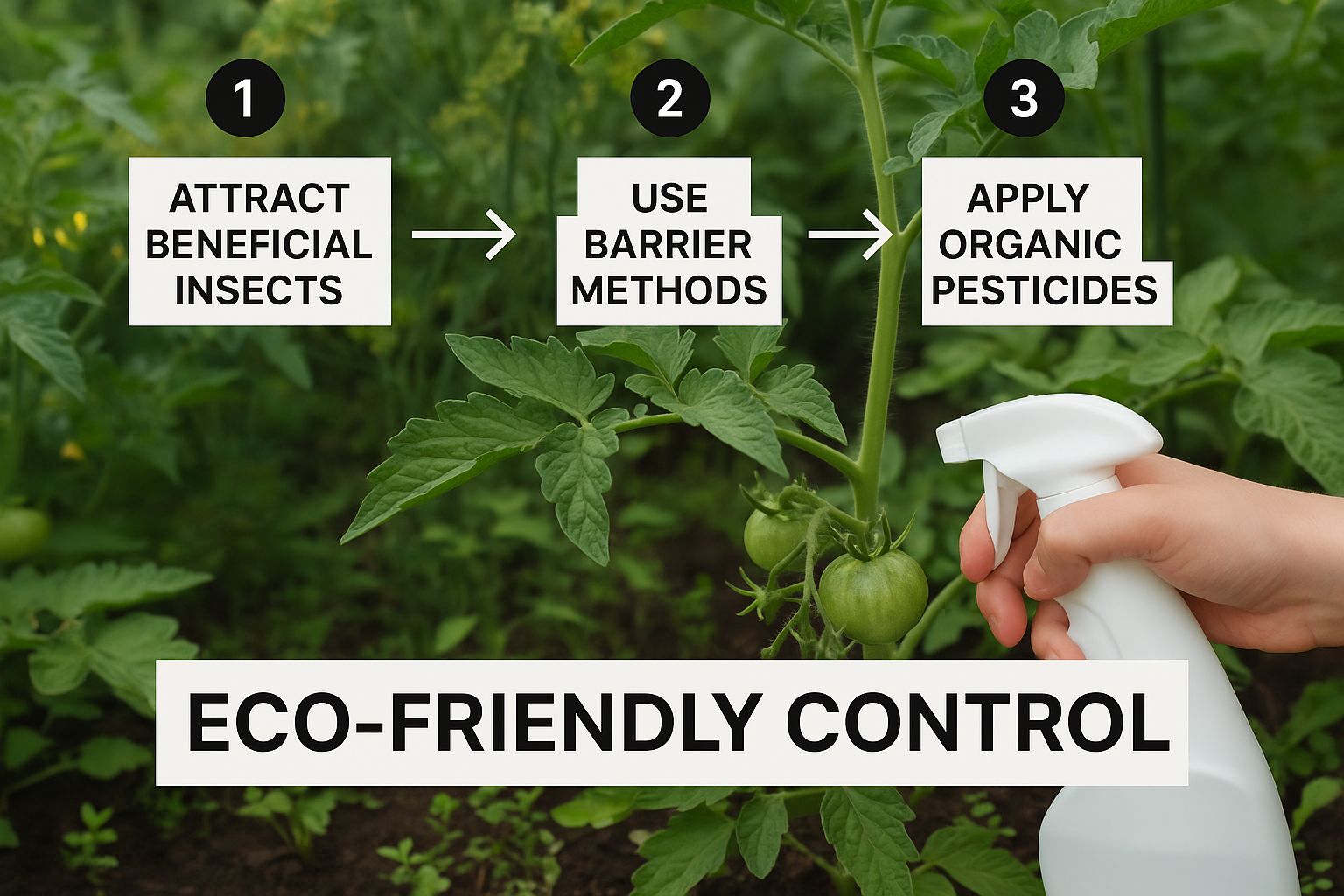
As the image highlights, successful and sustainable pest management always starts with a foundation of prevention and careful observation.
Step 4: Select and Integrate Control Tactics
If your monitoring shows a pest has crossed your action threshold, it’s time to choose how you'll respond. Following the IPM hierarchy, you should always start with the least disruptive methods first. This might mean introducing beneficial insects (biological), improving sanitation (cultural), or setting physical traps.
This pyramid shows how these methods are layered, from the most fundamental to the most intensive.
The IPM Control Methods Pyramid
| Level | Control Method | Example |
|---|---|---|
| Top | Chemical | Using a targeted, low-toxicity pesticide as a final option. |
| Mid-High | Biological | Introducing ladybirds to eat aphids. |
| Mid-Low | Physical/Mechanical | Using traps, barriers, or manually removing pests. |
| Base | Cultural/Prevention | Planting pest-resistant varieties, improving sanitation. |
Chemical controls should only ever be a last resort. When they are needed, the key is to select the most targeted, least toxic option available to minimise harm to other species and the wider environment. Often, the best long-term results come from combining several different tactics.
Step 5: Evaluate and Refine Your Programme
Finally, an IPM plan is never really "finished." It's a living strategy that needs ongoing evaluation. You should regularly review your monitoring data to see how effective your actions have been. Did the control method you chose bring the pest population back below the threshold?
Use these insights to refine your approach for the future. Perhaps a different preventative measure is needed, or maybe your action threshold was set a bit too high. This continuous loop of action, evaluation, and adjustment is what makes an IPM programme so resilient and effective over time.
The Real-World Benefits of Adopting IPM
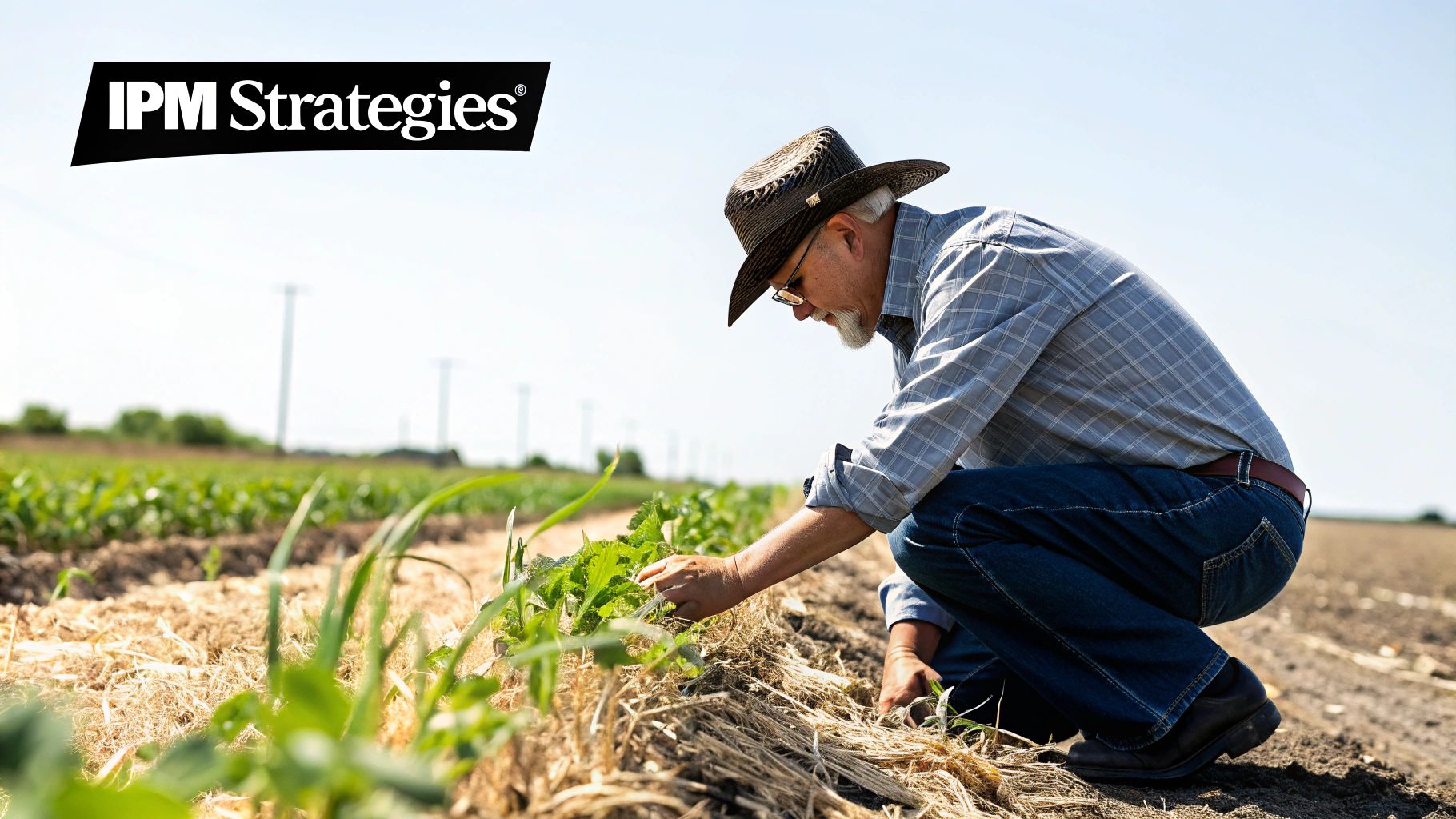
Switching to an Integrated Pest Management (IPM) mindset is more than just changing tactics; it's a strategic move with powerful, long-term advantages. The benefits ripple outwards, touching everything from your finances to the local wildlife. At its heart, IPM is about working smarter, not harder, for a healthier environment and a more resilient business.
This approach swaps the short-term fix of a chemical spray for the long-term goal of a balanced, self-sustaining ecosystem. Think of it as a practical investment in the future health of your property.
Boosting Environmental Health
One of the biggest wins from adopting IPM is the huge improvement in environmental wellbeing. By cutting back on broad-spectrum pesticides, you directly protect the creatures you actually want to keep around.
- Protecting Pollinators: Bees, butterflies, and other crucial pollinators are far less likely to be harmed by indiscriminate spraying, which helps support healthy plant life.
- Safeguarding Beneficial Insects: You keep the natural predators—like ladybirds and lacewings—that are already working for you, completely free of charge.
- Reducing Water Contamination: Less chemical runoff means cleaner local waterways, protecting fish and other aquatic life and improving overall water quality.
- Enhancing Biodiversity: A healthier, less-toxic environment allows a wider variety of plants, insects, and animals to thrive. While tackling specific issues like a UK spider infestation requires a targeted approach, IPM ensures the solution doesn't damage the wider ecosystem.
Strengthening Your Financial Position
While the green benefits are clear, the economic case for IPM is just as strong. There’s a common myth that sustainable methods cost more, but the opposite is often true in the long run. Simply put, reducing your reliance on expensive chemical pesticides lowers your operational costs.
Integrated Pest Management is not just an ecological choice; it's a sound business strategy. By reducing input costs and improving crop resilience, it builds a more predictable and profitable foundation for the future.
Healthier crops and environments mean more consistent yields, shielding you from the boom-and-bust cycles that come with heavy pest pressure. That kind of stability is vital for long-term planning and profitability.
Gaining a Market Advantage
The benefits don't stop at the property line. Today's consumers are increasingly savvy, demanding products and services that are produced sustainably and responsibly. Adopting IPM aligns your practices with what people actually want, giving you a real edge.
It also puts you in a great position to meet evolving UK environmental regulations with ease, making sure your operations are future-proof. Evidence for this balanced approach isn't new; it's been building for decades. The pioneering Boxworth Project, a UK government study from 1981–1991, proved that reduced-input farming could maintain yields while cutting costs and environmental harm, shaping modern IPM strategies. You can dig into these foundational findings on sustainable farming from Natural England.
How IPM Is Used Successfully Across the UK
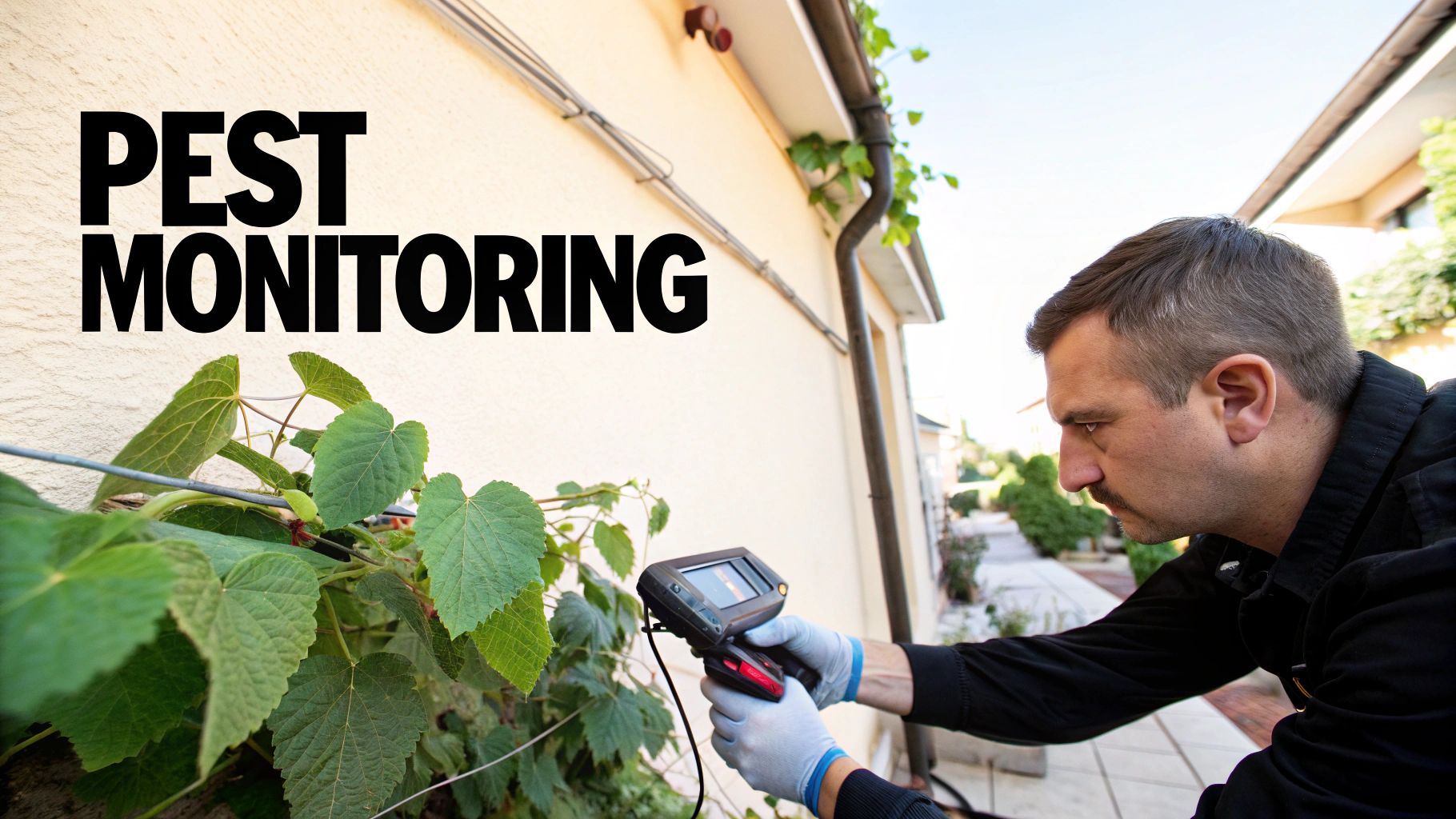
The principles of Integrated Pest Management aren't just theory—they're being put into practice every single day across the UK, in some surprisingly diverse places. Its real strength lies in its flexibility, making it just as suitable for large-scale farming as it is for the delicate job of protecting our national treasures. These real-world examples show just how powerful a smart, preventative mindset can be.
By looking beyond the fields and farms, we get a true sense of IPM's versatility. The core ideas—monitoring, prevention, and targeted control—offer a solid framework for almost any environment facing pest problems. It’s this adaptability that has made it so successful and widely adopted.
Protecting Cultural Heritage
You can find one of the most compelling examples of IPM in action within the walls of the UK's most beloved historic properties. Organisations like English Heritage are tasked with safeguarding irreplaceable artefacts, from ancient tapestries to antique wooden furniture, all of which are a tempting meal for pests like moths and wood-boring beetles.
Instead of just spraying chemicals, which could easily damage these delicate objects and the historic buildings themselves, they rely on a meticulous IPM strategy. It all comes down to a few key actions:
- Vigilant Monitoring: Using sticky traps and carrying out regular inspections to catch the earliest signs of pest activity.
- Environmental Control: Carefully managing temperature and humidity to create an environment where pests can't thrive.
- Structural Maintenance: Sealing up cracks and improving the building's integrity to simply block pests from getting in.
This proactive approach works wonders. The English Heritage IPM programme, which has been running since 1997, has been a huge success. A detailed report assessing pest risk at 115 heritage sites found the threat level to be low, proving that careful prevention protects our history far better than reactive chemical treatments ever could. You can discover more about their successful IPM strategies and what they found.
Innovating in Modern Horticulture
The UK's advanced horticulture sector provides another brilliant showcase for IPM. In massive commercial greenhouses growing everything from tomatoes to flowers, keeping pests away is essential for business. Here, biological controls are the star of the show.
Rather than relying on insecticides, growers release armies of beneficial insects to act as a natural security force. Ladybirds are deployed to hunt aphids, and predatory mites are introduced to control spider mite populations.
This carefully managed living ecosystem keeps pest numbers below damaging levels, ensuring healthy crops with very little chemical intervention. It’s a standard practice that shows how working with nature, not against it, is both good for the environment and good for the bottom line.
These examples, from priceless heirlooms to commercial greenhouses, highlight the universal power of IPM. For tailored solutions for your own property, you can explore professional pest control services that put these principles into action.
Common Questions About Integrated Pest Management
As people get to grips with Integrated Pest Management, a few key questions almost always pop up. Getting clear on these points is the first step to feeling confident about adopting this smarter, more sustainable way of handling pests.
Let's dive into some of the most common queries and clear up the confusion.
Does IPM Mean Going Completely Organic?
Not at all. This is probably the biggest misconception out there. While IPM and organic practices share a lot of common ground—like focusing on prevention first and using biological controls—IPM doesn't rule out chemical pesticides entirely.
Think of pesticides as a tool of last resort. The whole idea is to use them only when monitoring shows they are absolutely necessary to get a pest problem under control. It’s about being precise and responsible, not just going chemical-free for the sake of it.
Is an IPM Programme More Expensive Upfront?
Sometimes, yes. Kicking off an IPM programme can involve some initial costs. You might need to invest in better monitoring tools, seal up gaps where pests get in, or train staff on the new approach. But it's vital to see this as an investment, not just an expense.
Over time, a well-managed IPM strategy almost always saves you money. By cutting down on expensive pesticide use and preventing major infestations from ever taking hold, you lower your running costs and dodge the hefty price tag of emergency treatments.
How Long Until I See Results?
This really depends on the tactics you're using. Some preventative actions, like blocking up a mouse hole, deliver results almost immediately. On the other hand, strategies like building up populations of beneficial insects or improving your soil health are more of a long game.
They deliver gradual but far more permanent results. Unlike a quick chemical spray that offers a temporary fix, IPM builds long-term resilience. You might notice less pest activity within a few weeks, but the real financial and environmental payoff becomes clear over several seasons.
Can This Approach Work for My Small Garden?
Absolutely. The principles behind IPM are completely scalable. Whether you're managing a thousand-acre farm or a couple of window boxes, the thinking is exactly the same.
For a home gardener, IPM might look like this:
- Monitoring: Regularly checking your plants for the first signs of trouble.
- Prevention: Choosing pest-resistant plant varieties and encouraging friendly insects like ladybirds.
- Control: Hand-picking caterpillars off your cabbages or using a targeted soap spray only on the affected leaves.
The scale is different, but the thoughtful, proactive mindset is a perfect fit for any space, big or small.
Ready to implement a smart, effective pest management strategy for your property? At Pest Predators Limited, we combine scientific expertise with practical solutions to offer long-term protection. Discover our tailored, eco-friendly services at https://www.pestpredatorslimited.co.uk.


